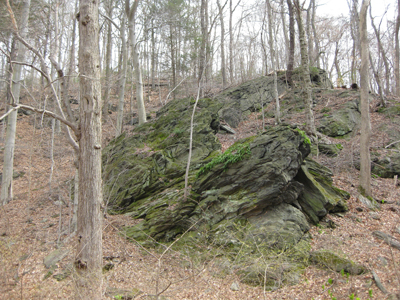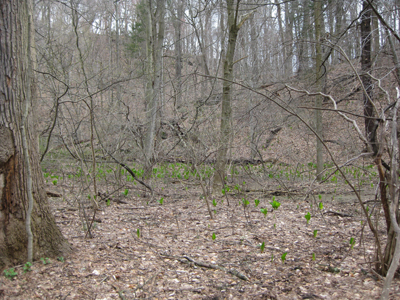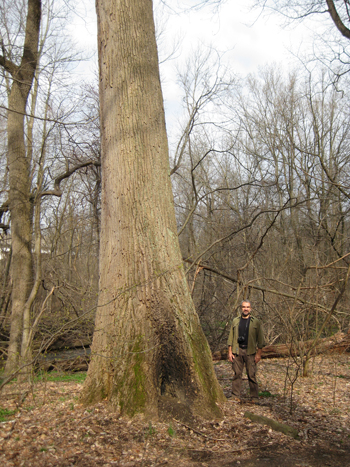Martin Forest

Today, I took a hike through the Martin Forest with conservation biologist, Roger Latham. The Martin Forest is a tract of land owned by Swarthmore College but not contiguous with other College lands. This 30 acre property was given to the College in 1926 by Dr. Edward and Anna Martin. This tract of land is located to the north of Baltimore Pike and is adjacent to the northern parts of Smedley Park. It is most easily accessed by the taking the Papermill Rd. into Smedley Park to the parking lot under the Blue Route (Rt. 476). Starting at the parking lot there is a trail that leads you along the Crum Creek through this beautifully wooded area. This trail forms one of the Martin Tract borders and continues into Jane Lownes Park in Springfield and other wooded, public lands in Springfield.
Professor John Harshberger, of the University of Pennsylvania, president of Botanical Society of Pennsylvania and the Pennsylvania chapter of the Wild Flower Preservation Society, described this forest in the 1903 edition of the Bulletin of the Torrey Botanical Club. In this article, he referred to the Martin Forest as a piece of land owned by Mr. J. Howard Lewis, Sr. who was one of the owners before the College took ownership. He says “Mr. J. Howard Lewis, Sr. and his progenitors have preserved inviolate a large tract of timber along Crum creek, while the surrounding country settled by patent in 1681 and 1682 has been cleared of its timber for many years. A study of such preserves shows the character of the original forest.” While this tract of land does not represent a true virgin forest, it probably at worst, has only been selectively logged over the centuries.

Symplocarpus foetidus, Shunk cabbage, emerging in the Martin Forest. photo credit: A. Bunting
The Martin Forest is still in very good shape; in fact, it represents some of the finest natural forest which the College owns. This forest has had very little impact by invasive exotics. In some of the low areas along the Crum Creek there are small populations of Ligustrum spp., privet and garlic mustard, Alliaria officinalis. Throughout the slopes I only occasionally spotted the multiflora rose, Rosa multiflora and only one plant of the burning bush, Euonymus alatus.
The botanical makeup of these woods is typical of the mixed deciduous forests found throughout southeastern Pennsylvania. The predominant hardwood species include tulip tree, Liriodendron tulipifera; red oak, Quercus rubra; white oak, Quercus alba; basket oak, Quercus montana; red maple, Acer rubrum; American beech, Fagus grandifolia, etc. The shrub layer consists primarily of spicebush, Lindera benzoin; witch hazel, Hamamelis virigniana; arrowwood viburnum, Viburnum dentatum; maple-leaved viburnum, Viburnum acerifolium and today we saw one specimen of the Pagoda dogwood, Cornus alternifolia. On the rocky slopes is mountain laurel, Kalmia latifolia. While the herbaceous layer has been significantly grazed by deer we did spot the following emerging today: bloodroot, Sanguinaria canadensis; trout lily, Erythronium americanum; mayapple, Podophyllym peltatum; wood aster, Aster divaricatus (syn. Eurybia divaricata). W saw growing in the swampy area, skunk cabbage, Symplocarpus foetidus and on the rocky slopes is a beautiful spreading fern, rock polypody, Polypodium virginianum. These woods also have a wonderful population along the Crum Creek of Eastern hemlock, Tsuga candensis. While these trees have been somewhat compromised by both Hemlock Wooly Adelgid and Elongate Hemlock Scale, they still remain magnificent specimens.

Roger Latham with the largest tree on Swarthmore College land, Liriodendron tulipifera. photo credit: A. Bunting
I had approached Roger originally about taking a hike into the Martin Forest to see the largest tree on Swarthmore College land. In one of the lower flood plains along the Crum is a stand of about 13 massive tulip trees, Liriodendron tulipifera. In particular, there is a massive towering specimen which has a trunk over six feet in diameter!
This is a beautiful tract of land that has had very little impact in view of on its borders. A walk along the trail will give you beautiful views of the Crum Creek, rocky outcrops, and our native flora.





Scott
Posted at 10:14h, 23 MayFound it!! This tulip tree is massive, particularly at its base where the trunk is hollowed out. In fact, I probably could have squeezed inside one of the two openings but didn’t. I’m curious about how the tree got this way & what else could be in there.
Andrew Bunting
Posted at 13:56h, 24 MayThe cavity is probably the result of some sort of injury many years ago. Most likely part of the interior of the tree has rotted away, but trees have an amazing ability to heal wounds over time.